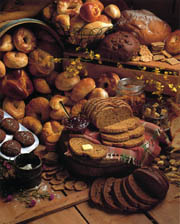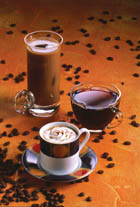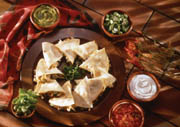
A trendy restaurant lives or dies by the chef's ability to evaluate customer feedback data and use that data correctly. Every party of four is a customer focus group. The results are real world and real time. It is said that nine out of 10 restaurant concepts fail. The ones that succeed are those that best respond to the customer's demands. Prepared Foods has interviewed some of America's premier culinary chefs to find out what these culinary superstars believe the upcoming trends in dining will be.

Small Plates
Voted America's number one restaurant, TRU Restaurant (Chicago) is on the cutting edge of the latest culinary trends, and has stayed there for years. Chef Rick Tramonto has created perhaps the best restaurant in the country.Chef Tramonto currently is opening a new restaurant, Osteria Via Stato (Chicago), that he believes will keep him and his food on the “chef's edge.” Chef Tramonto tells us, “Osteria Via Stato is an Italian restaurant that will focus on fresh and flavorful cuisine, amazing Italian wines and an emphasis on hospitality…Pairing small plates with a killer wine program is the trend of the future. Chef Suzanne Goin is doing this in a truly exceptional way at her restaurant, A.O.C., in Los Angeles. Her pairings are amazing. What I am trying to accomplish with Osteria Via Stato will be similar--but brought to an even higher level.
“Growing up with my Italian grandmothers, we cooked all the traditional dishes. When first going into the restaurant industry, however, I gravitated toward fine dining while working in restaurants all over the world. This pattern culminated in the opening of my progressive French restaurant TRU in Chicago-- with Rich Melman and pastry chef Gale Gand. I never lost my passion, though, for the fresh and flavorful Italian cooking that always remained close to my heart. Osteria Via Stato will give me the opportunity now to come full circle with this passion, while still doing what we have successfully done at TRU for the last five years. It is the best of both worlds and I feel truly blessed.”
As the driving force and executive chef behind TRU, Chef Tramonto has a long history of winning in the culinary trends business. During the next two years, he foresees continuing the small plates concept and impressing his guests. He is working on a casual home cooking book
“It's all about what you can bring to the table to keep pushing the bar of wowing our guests. There is no limit. We want to continue to expand my vision of great food, great wine and great hospitality in a casual setting.
“When we added the Seasonal Collections (degustations) to the Tru menu--focusing on one particular ingredient through a multi-course menu--this enabled us to work even more closely with farmers' markets, composing an entire 'study' of an individual item through a multitude of preparations and tastes.”
Pan-latino Foods
A winner of the James Beard award, Chef Norman Van Aken is known as the original creator of Nuevo Latino cuisine. He also is credited with creating the term (and the technique) known as “fusion” cuisine. His menus blend elements of traditional Old World “haute cuisine” with the brilliant flavors and textures of South America and the Caribbean Islands. Chef Van Aken owns Norman's restaurants in Coral Gables and Orlando, Fla.He writes, “Happily, America's eating habits and cooking methods have evolved and diversified more in the last 25 years than in the previous 175 years. This has led to great Nuevo Latino restaurants like Patria and Chicama in New York, Pasión in Philadelphia, Topolobamba in Chicago and Ciudad in Los Angeles.
There is an explosion of interest in Latin-Caribbean foods. This trend is not just seen in the tropical areas of Miami or Key West. From coast to coast, from Minneapolis to Massachusetts, “Americanized Mexican” cuisine is evolving into something richer and more complex. Chef Van Aken says, “The reality is that we can expect over 50% of the North American populace to be comprised of people of Latin decent by the year 2050 or earlier.”
He believes Brazil is the center of South American cuisine. Descendants of African slaves, indigenous natives and European settlers have blended their cuisines into a wonderful melting pot. Peru is a second hub of culinary diversity. Of course, Chile is known globally for its fine wines and world-class produce. Each of these culinary wellsprings shares a single source of recipe inspiration. Most of the countries of South America are primarily Catholic. All share the same calendar regarding carnivals, feast days and festivals. The street foods created over centuries to help celebrate these “universal” holidays offer a never-ending source of fabulous exotic tastes and techniques. Portuguese, Spanish, German and even Japanese settlers have added their unique cultural favorites to the South American mix.
Chef Van Aken has embraced these amazingly diverse cultures and cuisines. His menu at Norman's reflects his tremendous success in translating South American and Caribbean “carnival” cuisine into the fusion foods he calls Pan-latino. The growing success of the Caribbean-themed fast food chain, Pollo Tropical (whose menu is based on Caribbean carnival foods), proves the potential of such items.

Quality: Casual, Small and Simple
Chef Nick Zukin is a culinary expert and food journalist covering the Pacific Northwest. As editor of the daily culinary Internet blog, www.extramsg.com, Chef Zukin is constantly immersed in the world of gourmet dining. Many food marketers believe that America's lasting food trends start on the West Coast and move east. Zurkin's views and observations on the developing food scene in Portland, Seattle and San Francisco give a clear look into what may be coming from the restaurant region that gave us James Beard and Starbucks coffee.Chef Zukin observes, “Portland is embracing Chef Alice Waters' and Chef Paul Bertolli's (Chez Panisse Restaurant) approach of simple dishes made with high-quality, often organic, preferably local, ingredients. Restaurants like Clarklewis, Navarre, and Park Kitchen have expanded on places like Higgins, Genoa, and Wildwood, simplifying dishes even more, often serving smaller tastes, and keeping things very seasonal.”
Navarre has a ridiculously simple menu. For example, the word “chicken” is listed and patrons just put a check next to it on a slip of paper, like ordering out dim sum. But the simple word “chicken” may indicate a chicken dish braised in a spicy Spanish sauce.
Frivolities of all kinds take a backseat. There are no architectural presentations and the dining rooms are relatively spare. Casual quality is the key. Even desserts may just be a slice of a seasonal fruit tart with an in-house ice cream.
Another trend Nick reports on is that of food lovers opening artisan shops. A fantastic bakery, Ken's Artisan, opened up in Portland this last year. The owner, Ken Forkish, succeeded in the tech industry and instead of taking his stock options and retiring to Hawaii, opened up a naturally leavened bread shop. He truly cares about the food, not just the profit, and has insisted on a quality product.
Just down the street from Ken's is a market/co-op where John Gorham and Benjamin Dyer opened Viande Meats, with terrific patés and near-perfect pastrami. A couple of laid-off workers from the semi-conductor industry, Rodney and Kyle, both Texans, decided to bring real BBQ to Portland and opened up a shop. They also sell at the Portland Farmer's Market. Brian Spangler and his wife, Kim Nyland, started making pizzas for a nearby winery and then turned the operation into a restaurant. Brian hand tosses each pie himself and the couple soon will start making their own cheese daily when they move to a new location. These are neo-artisans and true food lovers. They care about making good food more than about profit or coming up with a concept that can be franchised.
Upscale Comfort Foods and Fine Wines
Chef Christian Gaborit, executive chef of Sofitel Hotel, has had great culinary successes in Chicago, Minneapolis and, of course, Paris. He states, “Chez Colette is the flagship restaurant in the Sofitel-Chicago O'Hare. The menu in Chez Colette reflects a growing trend in modern cuisine in France, particularly in Paris, toward modern regional food, comfort food. The Sofitel O'Hare receives guests from all over the world. Our menu must be cutting edge. Our guests have extremely sophisticated tastes. I believe that to differentiate us in our market, the French concept of focusing on the absolute highest level of service is certainly one of the most appropriate strategies. Our customers have asked for more regional French “root” foods. By that they mean regional European favorites prepared in the best possible manner; by that they mean upscale comfort foods.”Chef Gaborit also says he truly enjoys the fusion of French and Asian flavors. Nomi, a premier restaurant at the Park Hyatt Hotel in downtown Chicago, is doing this very well. When asked how he plans to compete with this powerful culinary opponent, nearly in his backyard, Chef Gaborit said, “We are working on wine-themed dinners through all of 2005. We had seven wine dinners in 2004 with renowned owners of wineries, and winemakers such as Clos Pegase and Shramsberg. We have seen exceptional success with this program. America is embracing fine wine.”
The chef also was asked to comment about the latest or last “permanent” change or addition made to his menu. Why was it done, and how did it affect the operation?
He replied, “Our latest major change was to introduce a number low-carb items, which were very successful at the time. However, I believe that this diet is a fad, not a long-term change in people's manner of eating.” He went on to say, “Sous vide will predominate many upscale kitchens in the near future. This will be driven by a need to reduce labor cost, improve quality and increase consistency of the product. This, I believe, will be a true, permanent change in the way we serve our customers.”
Coffee Craze Continues
A small but rapidly growing chain, the Caribou Coffee Company (Brooklyn Center, Minn.) never had a corporate research chef or a culinary R&D facility prior to Chef Kurt Stiles, executive chef and manager of R&D. Caribou now has over 300 units, and is growing at over 100 stores annually, with international expansion planned later this year. Chef Stiles has the enormous challenge of creating both the new products Caribou needs to continue growing, and building the department required to do so.He states, “Caribou was recently rated number one by Consumer Reports magazine for its Columbian coffee. Regarding quality food, we now have to make sure that our food is as good as our coffee.” When asked what trends he is watching and what restaurants are executing them well, Chef Stiles says he has been watching Solera, a restaurant in Minneapolis.
“It was recently voted one of the USA's top restaurants, and is on the cutting edge of international-world food. Their concept is a variation on tapas, the Spanish version of appetizers, and encompasses mini portions of various appetizers, entrées, salads, desserts, cheeses, cordials and cocktails. Most chefs I know normally eat this way, even when not in a tapas restaurant, to experience as many different flavors and foods from that particular restaurant's menu as possible. Solera's food is brilliantly fresh and the menu eliminates the least popular menu item once a month.”
Gourmet, Shelf-stable Products
With the help of manufacturers, food scientists and technologists, Caribou's plans include creating aseptically packaged or shelf-stable products for its chain, mass retail and upscale-gourmet stores. Chef Stiles opines, “The future of food and beverage is in shelf-stable products, including modified atmosphere-packaged products. Consumers will learn to accept aseptically packaged products, which will allow for cross-over from other markets.” He adds, “Convenience store items will soon include gourmet products.”
America's top chefs have proven their worth in predicting what America's consumers will be eating. And tomorrow they have to be right…again. Research chefs in the world's biggest food corporations often turn to their colleagues on the “front lines” for a glimpse into what may be on tomorrow's menus. Savvy marketing executives and product developers watch which way the “winds of change” blow. Sometimes, the winds of change start in the kitchen.